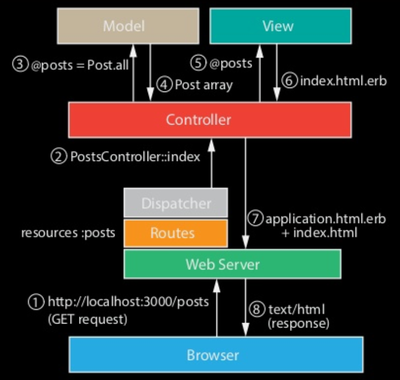MVC Implementation in Rails
Ruby on Rails
In Rails, the following classes support the MVC design pattern:
- Model – The ActiveRecord class, described previously, implements object-relational mappings (ORM).
- View – Views and controllers are actually bundled together in Rails in Action Pack. Dynamic content is generated by templates containing embedded Ruby (ERb) code supported by the ActionView class.
- Controller – The ActionController class is the core of a web request in Rails. It consists of one or more actions that are executed on request and then either render a template or redirect to another action. An action is defined as a public method on the controller, which will automatically be made accessible to the web-server through Rails Routes.
MVC Interactions in Rails
Example 1:- 1 The browser sends a request to the web server.
- 2 The web server processes the request, determines which route it belongs to and dispatches that request to the corresponding controller method.
- 1 The browser sends a request to the web server.
- 2 The web server processes the request, determines which route it belongs to and dispatches that request to the corresponding controller method.
- 3 The controller asks the model layer for all of the information needed to complete the request.
- 1 The browser sends a request to the web server.
- 2 The web server processes the request, determines which route it belongs to and dispatches that request to the corresponding controller method.

Latest Post
- Dependency injection
- Directives and Pipes
- Data binding
- HTTP Get vs. Post
- Node.js is everywhere
- MongoDB root user
- Combine JavaScript and CSS
- Inline Small JavaScript and CSS
- Minify JavaScript and CSS
- Defer Parsing of JavaScript
- Prefer Async Script Loading
- Components, Bootstrap and DOM
- What is HEAD in git?
- Show the changes in Git.
- What is AngularJS 2?
- Confidence Interval for a Population Mean
- Accuracy vs. Precision
- Sampling Distribution
- Working with the Normal Distribution
- Standardized score - Z score
- Percentile
- Evaluating the Normal Distribution
- What is Nodejs? Advantages and disadvantage?
- How do I debug Nodejs applications?
- Sync directory search using fs.readdirSync